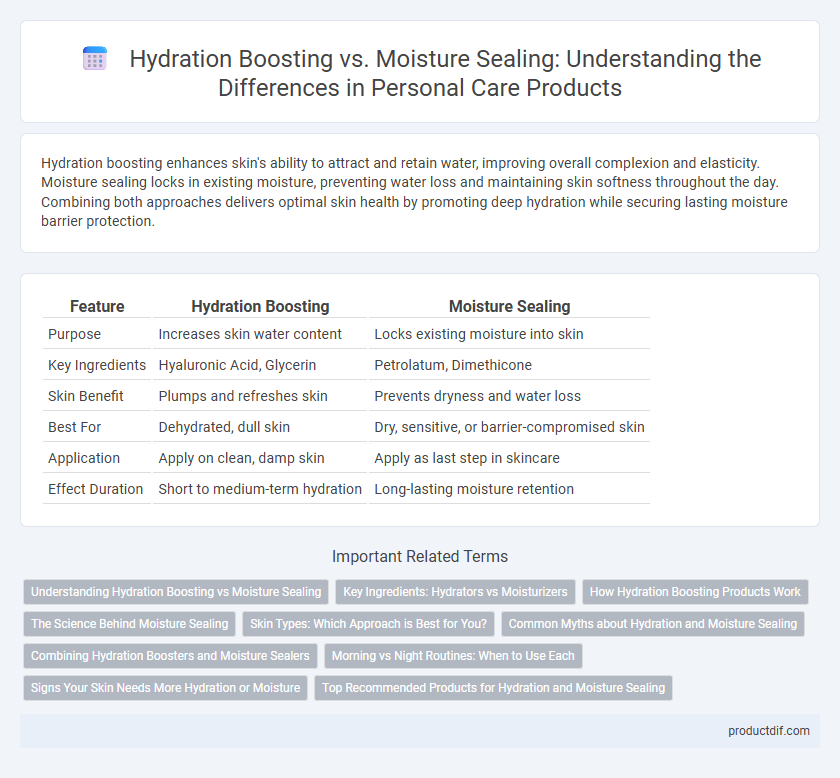Hydration boosting enhances skin's ability to attract and retain water, improving overall complexion and elasticity. Moisture sealing locks in existing moisture, preventing water loss and maintaining skin softness throughout the day. Combining both approaches delivers optimal skin health by promoting deep hydration while securing lasting moisture barrier protection.
Table of Comparison
| Feature | Hydration Boosting | Moisture Sealing |
|---|---|---|
| Purpose | Increases skin water content | Locks existing moisture into skin |
| Key Ingredients | Hyaluronic Acid, Glycerin | Petrolatum, Dimethicone |
| Skin Benefit | Plumps and refreshes skin | Prevents dryness and water loss |
| Best For | Dehydrated, dull skin | Dry, sensitive, or barrier-compromised skin |
| Application | Apply on clean, damp skin | Apply as last step in skincare |
| Effect Duration | Short to medium-term hydration | Long-lasting moisture retention |
Understanding Hydration Boosting vs Moisture Sealing
Hydration boosting involves increasing the water content within the skin cells to enhance skin plumpness and elasticity, often achieved through ingredients like hyaluronic acid and glycerin. Moisture sealing focuses on creating a protective barrier on the skin's surface to lock in existing moisture, typically using occlusive agents such as petrolatum, beeswax, or dimethicone. Understanding the distinction between these two processes helps in selecting personal care products that target either replenishing skin hydration or preventing moisture loss for optimal skin health.
Key Ingredients: Hydrators vs Moisturizers
Hydration boosting products primarily rely on humectants such as hyaluronic acid, glycerin, and aloe vera to attract and retain water within the skin, enhancing its natural moisture levels. Moisture sealing formulations incorporate occlusive agents like petrolatum, shea butter, and dimethicone to form a protective barrier that locks in hydration and prevents water loss. Combining both hydrators and moisturizers in skincare routines ensures optimal skin hydration and long-lasting moisture retention.
How Hydration Boosting Products Work
Hydration boosting products work by attracting and binding water molecules to the skin, often using ingredients like hyaluronic acid and glycerin that draw moisture from the environment into the epidermis. These products enhance the skin's natural water content, improving elasticity and reducing dryness from within. Unlike moisture sealing products that create a barrier to lock in existing moisture, hydration boosters actively increase the skin's hydration level for a plumper, more radiant complexion.
The Science Behind Moisture Sealing
Moisture sealing involves creating a protective barrier on the skin to lock in hydration and prevent water loss, typically using occlusive agents like petroleum jelly or silicones. This barrier minimizes transepidermal water loss (TEWL), maintaining skin plumpness and reducing dryness. Scientific studies show that effective moisture sealing enhances the skin's natural lipid layer, supporting long-lasting hydration and improved skin barrier function.
Skin Types: Which Approach is Best for You?
Hydration boosting products infuse water into the skin, ideal for dry and dehydrated skin types requiring immediate moisture replenishment. Moisture sealing formulations create a protective barrier to lock in existing hydration, benefiting sensitive or combination skin prone to moisture loss. Understanding your skin's specific needs helps determine whether enhancing moisture intake or preserving it offers optimal skin health and radiance.
Common Myths about Hydration and Moisture Sealing
Hydration boosting involves increasing the water content in the skin, while moisture sealing refers to creating a barrier that locks in that hydration. A common myth is that heavy creams alone provide hydration; however, they primarily seal moisture rather than add it. Effective personal care relies on combining humectants like hyaluronic acid for hydration with occlusive agents such as petrolatum to seal moisture.
Combining Hydration Boosters and Moisture Sealers
Combining hydration boosters like hyaluronic acid with moisture sealers such as occlusive ingredients creates a synergistic effect that enhances skin hydration and prevents moisture loss. Hydration boosters attract and bind water to the skin, improving plumpness and elasticity, while moisture sealers lock in the absorbed moisture, maintaining long-lasting softness and protection. This dual approach ensures optimal skin hydration, making personal care products more effective in combating dryness and promoting a healthy skin barrier.
Morning vs Night Routines: When to Use Each
Hydration boosting products, rich in humectants like hyaluronic acid, are ideal for morning routines to replenish moisture and prepare skin for the day. Moisture sealing creams containing occlusives such as petrolatum work best at night, locking in hydration and repairing the skin barrier during sleep. Using hydration boosters in the morning combined with occlusive sealants at night maximizes skin moisture retention and overall health.
Signs Your Skin Needs More Hydration or Moisture
Dullness, tightness, and flakiness are clear signs your skin needs more hydration, indicating a lack of water in the outer skin layers. In contrast, rough texture, persistent dryness, and increased sensitivity signal the need for moisture sealing to lock in hydration and reinforce the skin barrier. Identifying these distinct signs helps tailor your personal care routine with hydration boosting products like hyaluronic acid or moisture sealing ingredients such as ceramides for optimal skin health.
Top Recommended Products for Hydration and Moisture Sealing
Top recommended hydration boosting products include hyaluronic acid serums and aloe vera gels, which attract and retain water within the skin for long-lasting plumpness. For moisture sealing, occlusive ingredients like shea butter and petrolatum create a protective barrier that locks in hydration to prevent moisture loss. Combining both hydration boosters and moisture sealers in your skincare routine maximizes skin hydration and maintains optimal moisture balance.
Hydration boosting vs moisture sealing Infographic

 productdif.com
productdif.com